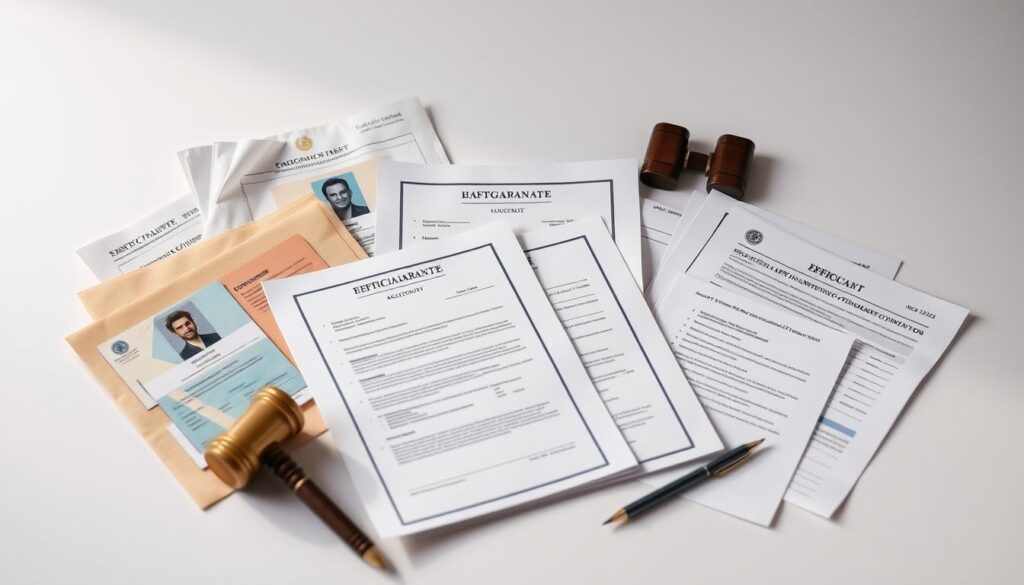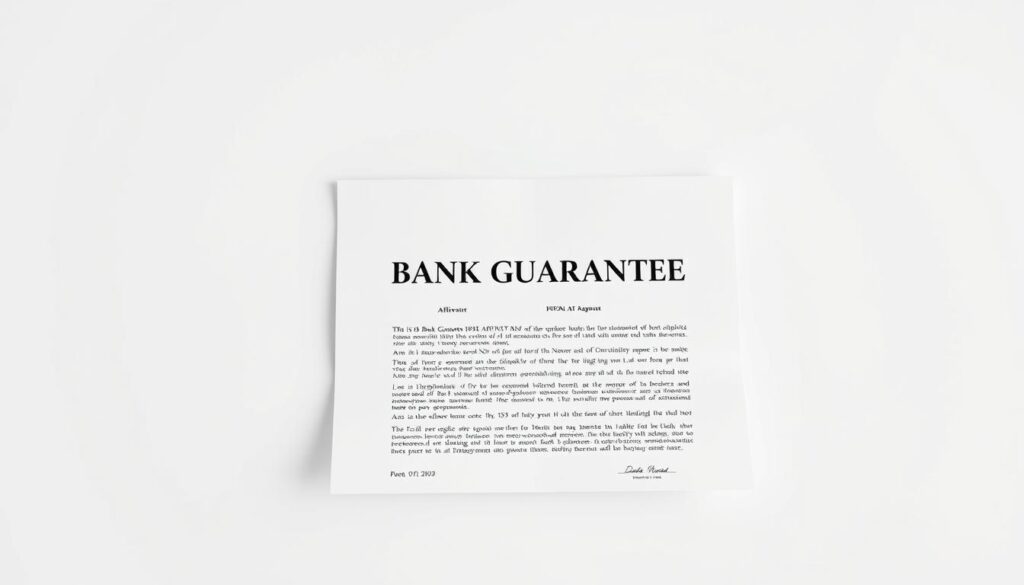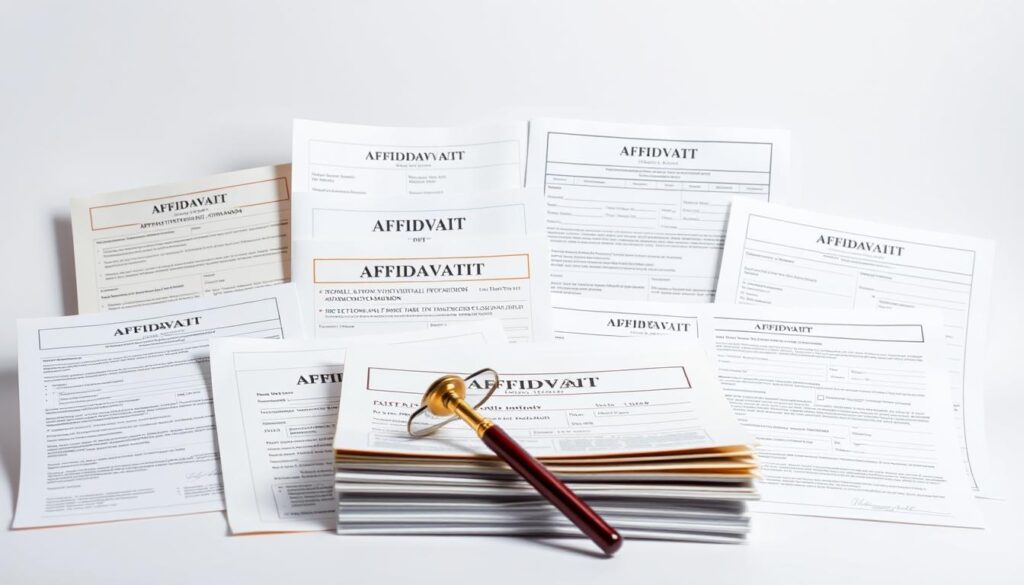Did you know that a single concise declaration can speed up a bank guarantee issuance by weeks for many Indian firms?
This section explains what that declaration is and why lenders and beneficiaries often request it.
You will see how the affidavit supports your application, ties the guarantee to an underlying agreement and clarifies the claim period. This helps the bank and beneficiary accept payment obligations with confidence.
The note also guides which facts must appear: authority, purpose, guarantee amount and links to purchase orders or contracts. That reduces queries and keeps your credit workflow smooth.
Practical benefit: clear statements limit delays, contain fees and protect your business accounts and credit lines whether you present papers at your branch or via digital channels.
Key Takeaways
- Understand why lenders and beneficiaries request an affidavit in the bank guarantee process.
- Know the essential facts to include: authority, amount, claim period and contract link.
- Learn where the affidavit fits among application forms and supporting documents.
- See how clear statements reduce risk, delays, fees and charges.
- Apply this approach across business sizes and trade sectors in India.
Understanding bank guarantees in India and where an affidavit fits
A bank guarantee is a written promise from an issuing bank to pay a beneficiary if a borrower fails to meet obligations.
Leading banks, NBFCs and lenders issue guarantees to reduce counterparty risk and provide immediate credit for business trade or project services. Collateral may include fixed deposits, stocks or mutual funds.
The affidavit sits alongside the application. It confirms authority, states the purpose and links the guarantee to the underlying agreement or purchase order. That clarity helps match account details and triggers for payment.
“Verify any received guarantee directly with the issuing bank using official channels before you ship goods or render services.”
Durations commonly range from 3 months to 10 years. Types include performance, bid bond, advance payment, financial and foreign guarantees. The claim period and any held deposits should appear in documents.
| Stage | Action | Why it matters |
|---|---|---|
| Application | Submit forms, KYC, collateral details | Enables credit assessment |
| Issuance | Bank issues guarantee | Bridges trust between buyer and seller |
| Invocation | Beneficiary claims payment | Bank pays if borrower defaults |
Documents required before you draft the affidavit

Before you prepare the affidavit, gather a clear set of records so the bank can verify identity, authority and financial standing.
Core application set
Start with the completed application form and a signed Bureau Consent form. Include KYC for borrower and guarantor, with photographs and PAN that match the account details.
Entity proofs
Produce partnership deeds for firms or a current director list and shareholding pattern for companies. Add a board resolution where authority must be shown, and any supporting agreement that links the guarantee to the deal.
Financials and banking
Provide three years’ ITR with computations and audited accounts (Form 3CA/3CB and Annexure 3CD). Add provisional results if requested, GST returns, month-wise sales and debtor ageing, and other bank statements (six months standard).
Collateral, stamp paper and supporting items
Show fixed deposit receipts, mutual funds statements or liens, plus Udyam registration and sector licences. Buy stamp paper of the correct denomination to avoid extra charges or re-execution.
“Organise files with clear names and a checklist; a tidy pack speeds credit decisions and reduces repeated queries.”
| Pack section | Typical items | Why it matters |
|---|---|---|
| Core | Application form, Bureau consent, KYC | Verifies identity and intent |
| Entity | Deeds, director list, board resolution | Proves authority and agreement links |
| Financial | ITRs, audited accounts, GST, bank statements | Supports credit and tax diligence |
How to Draft an Affidavit for Bank Guarantee: a step-by-step guide

Keep the declaration concise and precise. Identify the applicant, issuing bank and beneficiary. State the total amount, validity and the claim period so the payment scope is clear.
Reference the underlying deal. Cite the contract, purchase order or project page and attach the specific pages as exhibits. This helps the bank map obligations to the correct accounts and credit lines.
Declare authority. Name the signatory, show designation and attach the board resolution or partnership authority. Include a secretary’s certification when needed.
- Prepare annexures: ownership lists, client agreements and precise account identifiers.
- Label exhibits clearly (Annexure A, B) and cross‑reference in the body.
- Include identifiers like CIN, PAN or GSTIN and a service address for contact during the claim period.
Execute on the correct stamp paper, add place and date, and sign before a notary. State that all facts are true, with no omissions, and note any trust disclosures. File a signed copy with your home branch and retain originals for accounts and internal records.
Tailoring the affidavit to the type of bank guarantee and transaction
Match the affidavit text with the guarantee’s purpose — performance, bid security or an advance refund — so banks and beneficiaries see clear triggers.
Performance, bid bond, and advance payment
For a performance instrument, state deliverables, milestones and defect liability clearly.
For bid security, cite the tender ID, bid validity and the exact claim event.
For advance payment use a clause that shows the advance amount, refund triggers and any retention money.
Financial and deferred payment guarantees for goods and services
Set out repayment schedules, invoicing protocols and precise invoicing conditions that allow payment to the beneficiary.
Describe goods and services with HS codes or clear scopes, and list acceptance criteria so triggers match commercial reality.
Domestic versus foreign guarantees and supply chain considerations
State currency, governing law and whether a confirming bank or letter credit is involved for cross‑border trade.
Identify subcontractors or consortium partners and clarify which downstream obligations are covered or excluded.
“Beneficiaries should verify authenticity with the issuing bank; keep originals at your home branch for audit.”
| Guarantee type | Key affidavit points | Why it matters |
|---|---|---|
| Performance | Milestones, defect liability, site locations | Links payment to project completion |
| Bid bond | Tender ID, bid validity, invocation trigger | Prevents wrong or premature claims |
| Advance payment | Advance amount, refund events, retention | Protects lender and beneficiary funds |
| Deferred/financial | Repayment schedule, invoicing rules, account refs | Aligns claims with credit and accounts |
Fees, charges, and verification to protect your funds
Pricing, tax and authentication rules shape the real cost of a bank guarantee.
Plan your budget early. Many banks charge 0.50%–0.75% per quarter on the guarantee amount. Add 18% GST on banking services and expect processing, documentation and handling charges.
Collateral lowers fees and charges. Fixed deposits, stocks or mutual funds can reduce pricing. Unsecured instruments usually cost more and bite into your working capital and credit lines.
Typical fees, GST and factors affecting pricing
- Quarterly fee: 0.50%–0.75% of sanctioned amount.
- GST: 18% on banking services; include any tax gross‑up clauses in contracts.
- Extra costs: processing, documentation and handling fees may apply.
Collateral, working capital impact and covenants
Margins and limit utilisation affect available cash for operations. Review covenants with your finance and legal teams. Negotiate with your home branch for caps or bundled solutions.
Authenticity checks and fraud safeguards
Verify any guarantee directly with the issuing bank before you ship goods or make payments. Keep originals secure, validate specimen signatures and use dual controls for amendments.
| Item | Typical cost | Effect on working capital |
|---|---|---|
| Quarterly fee | 0.50%–0.75% of amount | Reduces available limit |
| GST | 18% on bank services | Tax on invoices; affects cashflow |
| Collateral | Fixed deposit, stocks, mutual funds | Can lower fees; ties up assets |
“Track fees, payments and expiry dates on a central calendar so renewals are not missed.”
Submission, follow-up, and compliance after issuance
After issuance, your next steps centre on filing the executed pack with the issuing bank and confirming processing timelines.
Filing and communication. File the signed affidavit, application pack and annexures with your home branch and obtain an inward reference. Confirm the standard processing timelines for the specific guarantee type and note the exact date of issue.
Keep dated records: a copy of the issued guarantee, claim period and expiry date, courier proof to the beneficiary, and any amendments or extensions. Map these items to the correct account and accounts ledger for audit and reconciliation.
Keeping records and monitoring
- Maintain originals in safe custody and scan all forms, declarations and trust or board resolutions.
- Create a diary of payment milestones and notices at 30/15/7 days before expiry to avoid lapses.
- Communicate status with the beneficiary to reduce risk of premature payment claims.
Amend, extend, cancel
When scope changes, time overruns or contract close‑out occur, request amendments or extensions with supporting documents. Factor the working capital and credit impact of any enhancement and seek approvals early.
“Collect the original instrument where required, obtain cancellation confirmation from the bank, and release any deposit or collateral.”
| Action | Why it matters | Who |
|---|---|---|
| File executed pack | Starts bank processing | Your treasury |
| Diary notices | Prevents accidental expiry | Project lead / accounts |
| Close loop | Frees deposits and clears accounts | Home branch / finance |
Conclusion
strong, Close the process with a short, validated statement that confirms authority, amount and the claim period for your bank guarantee.
File originals at your home branch and keep scanned copies linked to the right account. Note any pledged deposits or funds and the impact on credit and working capital.
Tailor wording to the guarantee type—performance, bid bond, advance payment or deferred payment—so payment triggers match goods and services and project milestones.
Keep a simple checklist for fees, GST and expiry dates. This helps your business protect money, maintain trust with the bank and speed final release of deposits at closure.
FAQ
What is the role of an affidavit in obtaining a bank guarantee?
An affidavit provides a sworn declaration confirming the truth of facts the bank relies on before issuing a guarantee. It sets out identity, authority, account and fund details, relationship to the underlying contract, and confirmations about encumbrances or collateral. Courts and banks treat it as a formal, legally binding statement supporting the guarantee application and protecting the bank against misrepresentation.
Which documents must you collect before preparing the affidavit?
You should gather the application form, KYC documents and credit bureau consent, entity proofs such as partnership deed or memorandum and articles, board resolution or director list, audited accounts, income tax returns, GST returns and recent bank statements. Also include collateral instruments, stamp paper, the underlying contract or purchase order, and any relevant supply or service agreements.
What key elements should the affidavit contain?
The affidavit must identify parties, state the purpose, specify guarantee amount and validity, reference the underlying contract or project, declare the signatory’s authority and internal approvals, list annexures like account details and ownership schedules, and record execution formalities such as date, place, stamp duty and notarisation.
How do you tailor the affidavit for different types of guarantees?
Adapt wording to the guarantee type — performance bonds, bid bonds and advance payment guarantees require specific obligations and claim events. Deferred payment and financial guarantees for goods and services need payment schedules and invoice references. For cross‑border guarantees, include currency, governing law and supply‑chain party details.
What verification and fraud checks should you expect from the bank?
The issuing bank will verify KYC, signatory authority, account balances, collateral charges and corporate records. Expect checks against public registers, confirmation calls, and verification of original documents. Banks may also run fraud detection and request additional undertakings or indemnities.
Which fees and charges apply when obtaining a guarantee?
Fees include issuance commission, document charges, GST and possible renewal or amendment fees. Pricing depends on tenor, amount, counterparty risk, and your working capital profile. Collateral costs or margin requirements and impacts on banking covenants may also affect overall cost.
How should the affidavit be executed to be legally enforceable?
Execute on the correct value of stamp paper and have the deponent sign before a notary public or magistrate as required. Include the place and date of execution, deponent’s identification, and witness details where applicable. Banks will usually require original notarised copies.
When must you update or amend the affidavit after issuance?
Amend when the underlying contract changes, the guaranteed amount or validity is extended, the signatory or authorised person changes, or when collateral arrangements are altered. Notify the issuing bank promptly and follow its prescribed amendment or extension procedures.
Can the affidavit affect working capital or other bank facilities?
Yes. A guarantee may draw on sanctioned limits or require additional collateral, affecting your working capital and credit utilisation. It can trigger covenant tests in loan agreements, so coordinate with your relationship manager and treasury team before signing.
What annexures and exhibits are normally attached to the affidavit?
Typical annexures include a list of authorised signatories, a copy of the underlying contract or purchase order, account details for debit instructions, ownership or shareholding schedules, board resolutions, and certified copies of supporting ID and entity registration documents.
How do domestic guarantees differ from foreign guarantees in drafting?
Foreign guarantees require clarity on governing law, dispute resolution, currency, presentation standards for documents, and may need apostille or consularisation. You should also address cross‑jurisdictional enforcement and any import/export or trade finance conditions.
Who should sign the affidavit within your organisation?
The affidavit should be signed by an authorised officer who has been authorised by a board resolution or power of attorney. The signatory must be clearly identified, and the affidavit should state their capacity and the basis of their authority.
What steps follow after submission of the affidavit to the bank?
The bank will verify the affidavit and supporting documents, may request originals, perform due diligence and, once satisfied, issue the guarantee. Keep copies of all filings, track timelines for issuance, and maintain communication with the bank until the guarantee is delivered.
Are there standard formats or templates you can use?
Many banks provide templates for affidavits and guarantee applications that reflect their compliance needs. Use the bank’s format where available, customise it to reflect the transaction specifics, and seek legal review for complex or high‑value guarantees.
What risks arise from inaccurate statements in the affidavit?
Misstatements or omissions can trigger bank refusals, liability for indemnities, civil or criminal penalties for fraud, and difficulty enforcing the guarantee. Ensure full disclosure and accurate representation of financials, encumbrances and authority.
Can personal assets be affected when corporate guarantees are issued?
Personal exposure depends on the presence of personal guarantees, director indemnities or security interest over personal assets. If you provide a personal guarantee or pledge personal property as collateral, those assets may be at risk.
What role do insurance and mutual funds play in securing a guarantee?
Insurance such as credit risk cover can reduce the bank’s exposure and lower fees. Pooled investments like mutual funds are generally not acceptable as direct collateral unless formally pledged and held in a lienable account under bank control.
How is tax treatment handled for fees and recovered claims?
GST applies to bank fees and commission. Recovery of claims under guarantees may create taxable receipts depending on the transaction nature. Consult your tax adviser to confirm treatment in your jurisdiction and to manage withholding or corporate tax implications.



